Sun Zhongjie
(Nanjing Silan Microelectronics Technology Co., Ltd.,Jiangsu Nanjing 210042)
Abstract:In recent years,how to reasonably use multiple rates for communication in BLE has received wide attention, but most studies focus on performance optimization at a single communication rate, which has a certain impact on the throughput of BLE device systems。To address these issues, a RSSI threshold-based BLE rate adaptive algorithm is proposed。Compared to traditional BLE single-rate communication, this algorithm can adaptively select the optimal rate for communication under different RSSI thresholds, thereby improving system throughput; at the same time, under the communication rate of 2 Mb/s, the algorithm can minimize transmission power, thus reducing system power consumption。This paper also uses the nRF52840 chip for algorithm verification, and from the measured results, the algorithm can maintain a throughput of 318 Kb/s at –40 dBm。
Keywords:RSSI Threshold; Rate Adaptation; Signal Strength Threshold; Bluetooth Low Energy; Throughput; Communication Rate
Classification Number:TN391.4 Document Identification Code:A
Article Number:2095-1302(2022)09-0057-03
0 Introduction
In recent decades, with the explosive growth of internet applications, there are more and more emerging miniaturized internet devices。These miniaturized internet devices, most of which have functions such as cloud communication、 voice recognition、 and self-organizing networks, further improve the quality of life [1]。The Internet of Things applications require various communication technologies, among which Bluetooth Low Energy(Bluetooth Low Energy, BLE) as an important short-range radio technology, plays an indispensable role in the Internet of Things [2]。
BLE is an energy-saving、 low-power、 low-cost、 and relatively simple short-range radio technology, originally designed for lightweight short-range data exchange。BLE is applicable in various application fields, thus achieving widespread adoption。In 2006, BLE was first introduced by Nokia, and was added to the Bluetooth 4.0 core specification in 2010 [3]。Since then, multiple versions have been standardized, and the overall performance of BLE has been optimized in the upgrades of versions。The Bluetooth Special Interest Group(SIG) released the BLE 5.0 version in 2016, and the BLE 5.3 version in 2021, to meet the multifunctional needs of the upcoming wave of Internet of Things applications。The BLE 5.0 Bluetooth specification does not only provide a data rate of 1 Mb/s as in previous versions(Bluetooth specification 4.2), but also adds three rate options:2 Mb/s、500 Kb/s, and 125 Kb/s[4]。Among them, the latter two combined with physical layer coding, although sacrificing data communication throughput, improve communication reliability。In addition, the BLE 5.0 Bluetooth specification also increases the maximum transmission power from 10 dBm to 20 dBm。In practical applications, due to the more choices of communication rate and transmission power in BLE 5.0, adaptive control of these two parameters can be performed, which can further improve the overall performance of the system without sacrificing communication quality, while reducing system power consumption。
However, currently there is little research on rate adaptive control algorithms for BLE 5.0。Badihi et al. [5] studied the transmission efficiency of multiple rates in BLE 5.0 in actual office environments, including performance such as communication throughput and power consumption。Bocker et al. [6] demonstrated the applicability of BLE 5.0 in complex communication scenarios from aspects such as frequency hopping algorithms。Karvonen et al. [7] obtained performance evaluation data for BLE 5.0 and BLE 4.0 through physical testing with the nRF52840 chip。Pau et al. [8] proposed an optimization scheme based on fuzzy logic, using fuzzy logic controllers to change transmission power to manage power consumption in BLE 5.0。Sheikh et al. [9] focused on analyzing the trade-offs between different PHY mode rates in BLE 5.0 and their impact on power consumption and throughput。The above studies focus on demonstrating the new outstanding performance of BLE 5.0, but do not conduct extensive optimization research on its new features。Especially in the case where BLE 5.0 has more choices for data rates, there is little research on how to utilize rate and power for adaptive control。
This paper proposes a RSSI threshold-based BLE rate adaptive algorithm, which dynamically selects the transmission power and rate of BLE based on the RSSI threshold, adaptively selecting the optimal rate for communication, thereby improving system throughput。At the same time, power control is used in high throughput areas, to reduce the power consumption of BLE。
1 RSSI Threshold-Based BLE Rate Adaptive Algorithm
In the BLE 4.0 protocol, the transmission rate of devices is constant at 1 Mb/s。In the BLE 5.0 protocol, the transmission rate of devices has become four types:1 Mb/s、2 Mb/s、500 Kb/s、125 Kb/s。
According to Shannon’s theorem:

Where:C is the channel capacity;B is the channel bandwidth;SNR is the signal-to-noise ratio。
Due to some newly added low rates(500 Kb/s、125 Kb/s) being lower than the original 1 Mb/s rate, according to Shannon’s theorem, the transmission power of the original devices will be lower than that of the low-rate devices。
In the BLE 5.0 Bluetooth specification, the basic method of rate switching is proposed, which is to switch rates through the PHY Update Procedure。The basic switching process is shown in Figure 1, after two devices enter the connection state, one of the devices initiates the PHY Update Procedure process, first sending the LL_PHY_REQ packet, to inform the other party of the desired communication rate for switching; the receiving party replies with the LL_PHY_RSP packet to inform whether it supports the communication rate; finally, the rate switching is completed through the LL_PHY_UPDATE_IND, allowing both devices to smoothly switch to the new communication rate。
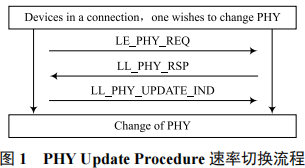
The PHY Update Procedure can complete the switching of multiple rates, but before switching, it must be ensured that both devices can support the communication rate to be switched to。In different environments, for example, when the distances between the two devices are different, this process can be dynamically used for rate switching, ensuring that both parties have the optimal communication throughput。
In the BLE 5.0 Bluetooth specification, the basic method of power control is also proposed, which is to control power through the Power Control Request Procedure。The process is shown in Figure 2, which involves the interaction of LL_POWER_CONTROL_REQ and LL_POWER_CONTROL_RSP, allowing both devices to minimize transmission power while ensuring communication quality。
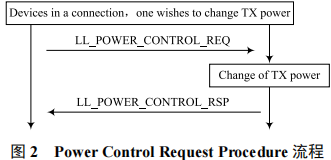
Based on the above two processes, this paper proposes a RSSI threshold-based BLE rate adaptive algorithm, the specific process is shown in Figure 3。The algorithm first obtains the RSSI value of the other device in the connection state, and then selects the rate based on the set RSSI threshold value。If the current RSSI value is below the RSSI_500K threshold, then select the transmission rate of 125 Kb/s; if the current RSSI value is between the RSSI_500K threshold and the RSSI_1M threshold, then select the transmission rate of 500 Kb/s; if the current RSSI value is between the RSSI_1M threshold and the RSSI_2M threshold, then select the transmission rate of 1 Mb/s; if the current RSSI value is above the RSSI_2M threshold, then select the transmission rate of 2 Mb/s, while performing power control between devices。It is important to note that, each rate selection should maintain the current rate for a period of time, to ensure that the RSSI value does not change during this period。This rate adaptive algorithm can ensure that the communication throughput between connected devices is maximized as the RSSI value changes。
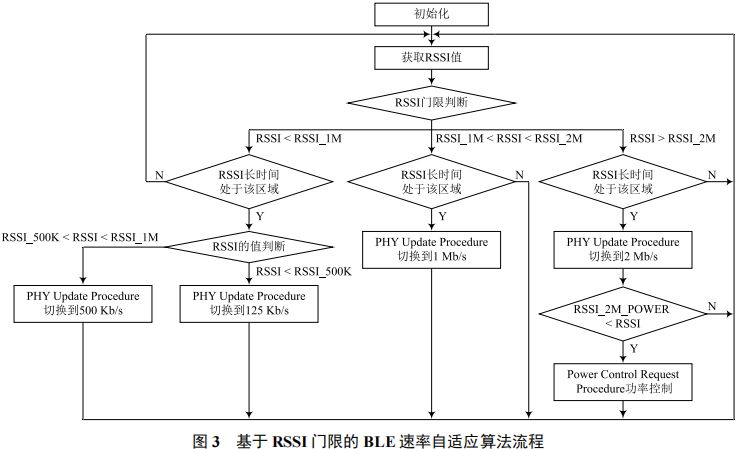
This algorithm is based on the selection of the RSSI_2M threshold, adding a power control algorithm, that is, when the devices are close to each other, the communication throughput between the devices is basically approaching the limit。At this time, the transmission power of the devices can be appropriately reduced, as long as the throughput limit can be maintained。By reducing the transmission power of the devices, it is possible to lower the power consumption of the devices, while also reducing interference to surrounding devices。
2 Testing and Analysis
2.1 Testing Parameters
This paper selects the nRF52840 chip as the experimental chip, which complies with the BLE 5.0 standard, and can perform multiple processes such as PHY Update Procedure [10]。Table 1 shows the basic parameter configuration of the nRF52840 during the experiment。
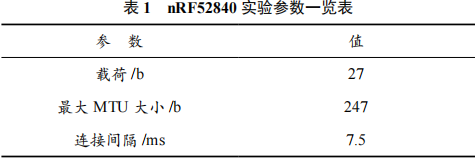
2.2 Testing Results
Figure 4 reflects the relationship between the transmission power and power consumption of the nRF52840 chip at different rates。At the same transmission power, when communicating at a rate of 2 Mb/s, it has the lowest power consumption; while communicating at a rate of 125 Kb/s, it has the highest power consumption。At the same time, under fixed transmission rates, the greater the transmission power, the more energy consumed。
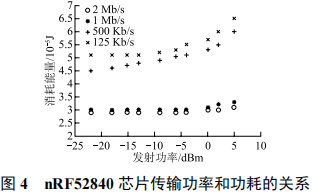
Figure 5 shows the relationship between the RSSI value and throughput under traditional single-rate communication。It can be seen from the figure that, when the RSSI is greater than –83 dBm, the throughput of 2 Mb/s is optimal; when the RSSI is between –83~–90 dBm, the throughput of 1 Mb/s is optimal; when the RSSI is between –90~–98 dBm, the throughput of 500 Kb/s is optimal; when the RSSI is less than –98 dBm, the throughput of 125 Kb/s is optimal。At the same time, when the RSSI is greater than –55 dBm, the throughput of the device changes little, even if the RSSI increases, it will not significantly increase the throughput of the device。
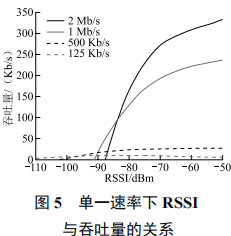
According to Figure 5, this paper selects the RSSI_2M value as –83 dBm, the RSSI_1M value as –90 dBm, the RSSI_500K value as –98 dBm, and the RSSI_2M_POWER value as –55 dBm。
Figure 6 shows the relationship between RSSI and throughput tested on the nRF52840 chip using this algorithm。From the figure, it can be seen that when the RSSI value is below the RSSI_500K threshold, then select the transmission rate of 125 Kb/s; if the current RSSI value is between the RSSI_500K threshold and the RSSI_1M threshold, then select the transmission rate of 500 Kb/s; if the current RSSI value is between the RSSI_1M threshold and the RSSI_2M threshold, then select the transmission rate of 1 Mb/s; if the current RSSI value is above the RSSI_2M threshold, then select the transmission rate of 2 Mb/s, while performing power control between devices。The power control threshold is –55 dBm, at this time, the devices adjust their transmission power, as long as they can maintain the throughput limit。It can also be seen from the figure that, the maximum throughput can reach 318 Kb/s。
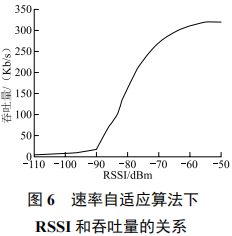
From the testing data, it can be concluded that the rate adaptive algorithm proposed in this paper can dynamically select the optimal rate for communication as the RSSI changes, to ensure that the communication throughput is maximized。
3 Conclusion
This paper proposes a RSSI threshold-based BLE rate adaptive algorithm on the basis of traditional single-rate communication, dynamically selecting the transmission power and rate of BLE through the RSSI threshold, adaptively choosing the optimal rate for communication, thereby improving system throughput。At the same time, power control is used in high throughput areas, which can reduce the power consumption of BLE; and through actual testing with the nRF52840 chip, it can be seen from the testing data that the algorithm can achieve the expected effect, maintaining a throughput of 318 Kb/s at –40 dBm。
References
[1] AL-FUQAHA A,GUIZANI M,MOHAMMADI M,et al. Internet of Things: a survey on enabling technologies,protocols,and applications [J]. IEEE communications surveys & tutorials,2015,17(4):2347-2376.
[2] Li Yingchuan,Wang Junji,Yao Wei,et al. Research on security mechanisms of low-power Bluetooth technology [J]. Internet of Things Technology,2020,10(9):51-53.
[3] XU Jinguo . Research and implementation of the core technology protocol of Bluetooth 4.0 [D]. Shanghai: Shanghai Jiao Tong University,2013.
[4] Wang Wei . Characteristics of Bluetooth 5.1 standard and testing schemes [J]. Information Communication Technology and Policy,2019,45(5):98-99.
[5] BADIHI B,GHAVIMI F,JANTTI R. On the system-level performance evaluation of Bluetooth 5 in IoT: open office case study[C]// Proceedings of 16th International Symposium on Wireless Communication Systems(ISWCS 2019). Oulu,Finland:IEEE,2019.
[6] BOCKER S,ARENDT C,WIETFELD C. On the suitability of Bluetooth 5 for the Internet of Things: performance and scalability analysis [C]// Proceedings of 2017 IEEE 28th Annual International Symposium on Personal,Indoor,and Mobile Radio Communications(PIMRC). Montreal,QC,Canada :IEEE,2018.
[7] KARVONEN H,POMALAZA-RÁEZ C,MIKHAYLOV K. Experimental performance evaluation of BLE 4 vs BLE 5 in indoors and outdoors scenarios [C]// Proceedings of International Conference on Body Area Networks. Dalian:ACM,2017.
[8] PAU G,COLLOTTA M,MANISCALCO V. Bluetooth 5 energy management through a Fuzzy-PSO solution for mobile devices of Internet of Things [J]. Energies,2017,10(7):1-22.
[9] SHEIKH M U,BADIHI B,RUTTIK K. Adaptive physical layer selection for Bluetooth 5:measurements and simulations [J]. Wireless communications and mobile computing,2021,2021:1-10.
[10] Dong Heng . Design of display controller for Bluetooth 5.0 chip nRF52840 [J]. Microcontroller and Embedded System Applications,2020,20(4):79-82.